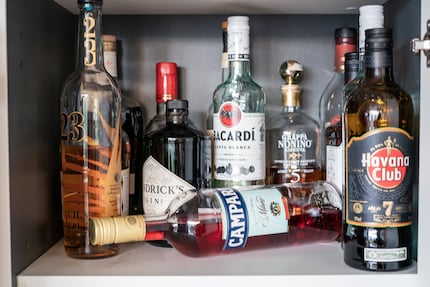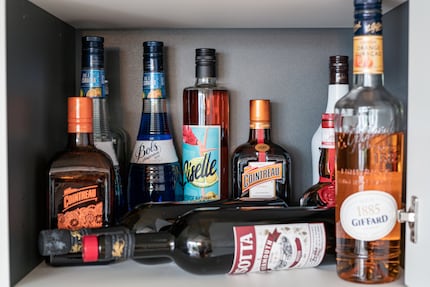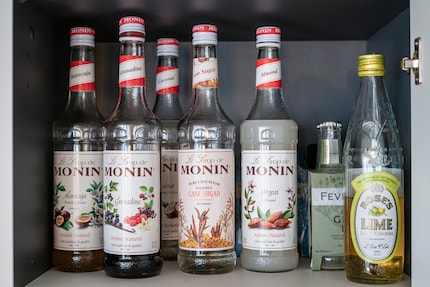
Guide
What all belongs in a house bar - utensils and glasses
by Oliver Fischer

I have set up a home bar for myself. What it really needs for it and what you can do without, I have summarized once. This part is about spirits and mixed drinks.
Whether in my home town of Chur, in small Zurich or in big Berlin - a good bar is a good bar. Countless glasses of various shapes and sizes are stacked on, at or against the wall behind the bar. Shakers, measuring cups, spoons and drinking straws are neatly lined up and waiting for the bartenders' nimble hands. Countless schnapps and liqueurs line up and are shaken and stirred with themselves, chilled lemonades or fruit juices to make sweet, fruity, sour or bitter cocktails.
Of course, only a fraction of the bar utensils are needed in your and my home bar. But which one? The offer is gigantic and the space in the private kitchen is limited. So here's a summary of what's available in terms of spirits, liqueurs and other liquids. Most importantly, what you should buy for your home bar - and what I put in my bar.
You can read about the tools, shakers and glasses I have in my home bar here:
I bought three cocktail recipe books to see what drinks even exist and what ingredients you need to make them. Of course, some of the classics are represented threefold. All in all, I would say that there are several hundred cocktail recipes. The simplest ones consist of three, the most complicated ones of eight to ten ingredients - not including the decoration. Now I don't want to be able to mix every one of these drinks immediately. But I do want a small, fine selection of classic and modern cocktails.
I won't go into too much depth about the different spirits, liqueurs and filler drinks here. I'll try to give you an overview of the most important ingredients that belong in a home bar.
According to the dictionary, spirits include all drinks with an alcohol content of more than 20 percent by volume, other sources even say from 15. However, I only include high-proof drinks, which are commonly referred to as schnapps, and deal with liqueurs separately.

Vodkas are usually wheat or potato distillates that are clear and virtually odorless and tasteless. They are usually sold at 40 to 44 percent by volume. Vodka is odorless because it is distilled to 96 percent by volume during production and then diluted with water. In principle, vodka can be made from any raw material containing carbohydrates. In various countries, e.g. France, there is also vodka made from grapes.
In simple terms, gin is raw alcohol that has been flavoured with various herbal flavouring agents. Juniper must be the dominant flavouring. In addition, other so-called botanicals such as coriander seeds, citrus fruits, ginger or any other can be added at will. The flavouring is done by single or multiple distillation of the raw alcohol. The botanicals may be steeped in it, or the alcohol vapor may be passed over the botanicals, taking the flavors with it. In Switzerland, gin must have an alcohol content of at least 37.5% by volume.
Is mezcal a subspecies of tequila or vice versa? Both are spirits from Mexico, distilled from the heart of the agave plant. To answer the question: tequila is a type of mezcal. So: every tequila is also a mezcal, but not every mezcal is a tequila. Two criteria are important: first, the geographical origin and second, the raw materials. Mezcal is made from different types of agave and must be at least 51 percent produced from the juice of agave. Tequila is a type of mezcal that is made from a single species of agave, the blue agave, and also only in some regions around the city of Tequila. It is common for tequila to have an alcohol content of 38 to 40 percent.
Tequila is also divided into two purity levels and five aging groups. Either a tequila consists of 100 percent agave or at least 51 percent, with the rest usually being cane sugar. The pure tequila may only be shipped in bottles, the so-called mixto also in barrels. The five age levels are called:
Rum comes in white and brown. Quite simply? Rum is mainly made from cane sugar molasses. There is also rum made from fresh cane sugar juice. After distillation, the alcohol content is between 65 and 75 percent by volume. By diluting it with distilled water, white rum is produced. This is stored either in stainless steel barrels or in wooden barrels. Through the storage in wooden barrels, it takes on a more or less intense colour, depending on the duration of the storage, whereby it becomes brown rum. In addition, the taste of the rum changes. Rum originates from the Caribbean, whereby it is important from which island it comes. There are cocktails, for example the Planter's Punch, for which different rums from different islands are used in the original recipe.
Yes, these different spellings are important and (mostly) have to do with origin. Whiskey is spelled booze in Ireland and the US, whisky in Scotland. But there are exceptions. And there's no rule for whisk(e)ys from other countries around the world, like Switzerland or Japan.
So now to the essentials: Whisky is distilled from grain. That can be wheat, rye, oats or any other grain. In the EU there is a minimum storage period of three years in wooden barrels. Other countries have their own rules. These specify, for example, the alcohol content - in the EU at least 40 percent by volume - or the distillation process. In the USA, whiskey made from corn is widely known as bourbon.
These are the five most important spirits that should also find a place in a small home bar. But because I already had several whiskies, two gins and one white rum and vodka each at home, I only added a brown rum and a tequila. I've done well with that so far. The various fruit brandies I also have have not found use in cocktails so far.
As I said, liqueurs officially count as spirits. Liqueurs are defined by their sugar content, which must be at least 100 grams per liter. Usually they have an alcohol content between 15 and 35 percent by volume, although there are exceptions towards the top.

Liqueurs are usually produced by one of two processes. First, there is maceration. Herbs or fruits are soaked in alcohol and then distilled. Then they are diluted again and sweetened. Secondly, there are mixed liqueurs, for which alcohol is mixed with water, sugar and syrup.
Well-known and quite widespread liqueurs are:
Bitter liqueurs
A special category within the liqueurs are bitters, which are in the same category as sweet liqueurs in terms of alcohol content, but have a bitter taste. These include for example:
The lists above are very selective and could get long. As a mixed drink for cocktails, by no means all of them are in my home bar. In fact I have a Cointreau (orange liqueur), a bottle of Malibu (coconut liqueur), a bottle of Blue Curaçao (orange liqueur) because of the colour, an Aperol and a Campari. But I really only need the Cointreau, the Aperol and the Campari regularly. But that may simply be due to my personal preference for rather sour and bitter drinks.
In principle, classic red and white wines are also used in cocktail culture. However, some special wine variants are more common.
A carbon dioxide overpressure of at least 3 bar, an alcohol content of at least 9.5 percent by volume and an indication of origin on the label: these are the requirements that a wine must meet in order to be considered a sparkling wine. In Germany and Austria, sparkling wines are known, in Italy prosecco and in France, of course, champagne. A distinction is made between seven degrees of sweetness, from sweet to dry to naturally sweet.
Fortified or fortified wines or also liqueur wines are wines which are enriched with alcohol during production. Sweet wines such as the Italian Vin Santo, Port wines, Marsalas or Muscats belong to this category. For cocktails more important than sweet wines are the also fortified, but not sweet, wines sherry and especially vermouth. Sherry comes from southern Spain and is a dry white wine that is fortified with brandy and then fermented again. Depending on the type, sherries have between 14.5 and 17 percent alcohol by volume. Wormwood owes its name to the wormwood herb with which the fortified wine is additionally mixed and whose bitter aromas it absorbs. Vermouth is available in red, white or rosé, depending on the wine of origin.
In my house bar there is one bottle each of white and red vermouth. Also available are port and marsala, but these are more for cooking and (so far) not for cocktails. In the past I had one or the other bottle of sparkling wine and champagne on hand, in case there was something to celebrate, and now they are also used for a drink.
Syrups add sweetness, flavor and sometimes color to cocktails. The variety in the well-stocked retail trade is almost inexhaustible: from classic fruit syrups to spices to herbs and on to nuts or even coffee, ginger and basil. In cocktail bars, however, it is also quite normal to make the syrups you need yourself for your own creations. Recently I read about carrot, cucumber and beetroot syrups.

In my bar cupboard there is a pure sugar syrup, which I need most often, an almond syrup (for Mai Tais), grenadine and also passion fruit, coconut. The latter are all still practically full though....
Fillers, in cocktail culture, are mixed drinks used to top or stretch drinks. Collectively, these include sodas, mineral waters and fruit juices. In principle, sparkling wines can also be counted among them and even beer sometimes serves as a filler. Mineral water is often used, which does not change the taste of a drink. With cola, ginger ale, ginger beer, tonic or any other kind of lemonade a drink can be additionally sweetened or changed in taste. The same goes for fruit juices, with orange, lemon and lime juice being the most common. But pineapple, cranberry or grapefruit juice are also common.
Orange juice usually has it in my kitchen anyway. So do ginger beer and tonic. Pineapple, cranberry and grapefruit juice are often on hand now too. I squeeze lemon and lime juice fresh and there's always a bottle of mineral water in the fridge too.
Now we're getting into spheres that aren't really essential for a home bar. Cocktail bitters are alcoholic liquid condiments. Their taste is, as the name suggests, more or less bitter, but can vary greatly in addition. Basically, as with syrups, you can make a cocktail bitter from pretty much any botanical ingredient. Most often, bars need the same two or three bitters: angostura, orange, and lemon. Bitters are only used in tiny amounts, single drops or dashes.
So far I don't have any bitters at home, but I'm already thinking about ordering a bottle of Angostura.
Cocktails are not only about taste and appearance, but also about texture. To change the texture, some cocktail recipes use either cream or egg white as an ingredient. This shouldn't be a problem in any kitchen, I - and I'm sure you - always have it in the fridge.
Deco
The eye drinks with you. To present your drink in the best light, you need fresh citrus fruits for slices or zests, cocktail cherries, a fresh pineapple or even a cucumber. At most, I purposefully buy citrus for cocktails. But most of the time it's simply: I've just got them, or I don't. Oh yes, I almost forgot: Cocktail skewers to skewer the cherries and drinking straws! Very important.
Finally, here is a summary of what belongs in a simple home bar:
This is the basis for a large number of classic drinks and their variations. For this you need fresh fruit and other fillers. But you'd better buy them specifically if you really want to use them.
Why I had the idea to set up a home bar in the first place, you can read here:
Globetrotter, hiker, wok world champion (not in the ice channel), word acrobat and photo enthusiast.
Practical solutions for everyday problems with technology, household hacks and much more.
Show all